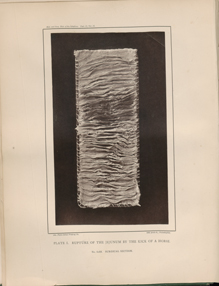Title: R——, Frank
Source text: The Medical and Surgical History of the War of the Rebellion. (1861-65.), Part 2, Volume 2 (Washington, DC: Government Printing Office, 1876), 23.
Civil War Washington ID: med.d2e31499
TEI/XML: med.d2e31499.xml
CASE 119.—Frank R——, aged 11 years, a servant of Mr. Smoot, Ordnance Corps, was kicked by a horse in the lower umbilical region, while assisting a child to mount. On receiving the blow he ran to the house and examined the injured part, and then walked a short distance to his mother's quarters, crying. He was put to bed, and was presently attended by Dr. J. S. Kennedy, who found him, half an hour after the reception of the injury, vomiting blood, complaining of great nausea, and great tenderness over the umbilical region, but of no acute pain. The pulse was accelerated and the heat of surface augmented. There was no abrasion or visible contusion of the surface. An anodyne was prescribed, and absolute rest in the easiest posture. At the Doctor's second visit in the evening, the stomach was less irritable, but the abdominal tenderness was extreme, and extended to the hepatic region, and was attended with much pain, referred chiefly to the right hypochondrium. During the night, the febrile disturbance augmented; there was excessive restlessness and anxiety, with occasional retching. In the morning, Dr. Kennedy found the little patient almost moribund; a clammy sweat covered the surface; the pulse was rapid and thready; the patient was conscious and free from pain. He never rallied from this condition, and expired twenty-four hours after the reception of the injury. The remains were sent to Washington, where a post-mortem examination was made by Dr. J. F. Hartigan. Careful inspection could not reveal the slightest contusion or ecchymosis externally, nor extravasation in the abdominal muscles. About half a pint of clear serum was contained in the cavity of the abdomen; the peritoneum was agglutinated in various parts, and bands of lymph covered the intestines. About the middle of the jejunum there was found a small rupture of about half an inch, irregular in shape, surrounded with coagula. The other organs were healthy. The notes of the cases, and the specimen, No. 6188, represented in PLATE I, were contributed to the Museum by Dr. J. F. Hartigan.
